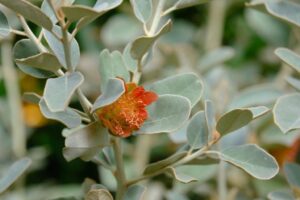Four new Australian Idylls!
By Gabrielle Stannus
Before arriving at this year’s Melbourne International Flower and Garden Show at the Royal Exhibition Building and Carlton Gardens in Melbourne, I decided that I was going to focus my attention on the plant life on display. And boy, I was not disappointed! Indeed, I was pleasantly surprised to find that the plants were the real heroes in this year’s display gardens, and that the Australian landscape was a key inspiration. I heard on the grapevine that a change to the Show judging criteria may have influenced this shift. However, speaking with the designers behind four of the Landscape Design Show Gardens, I believe that their design philosophy inherently underpins their work, i.e. they do not need to be told to include more plants! Take a tour with me of those gardens to find out more about the beautiful indigenous and native plants that were on display.
Wurundjeri biik – Indigenous Garden
The “Wurundjeri biik (Wurundjeri Country) – Indigenous Garden” was co-designed by Royal Botanic Gardens Victoria Landscape Designer, Andrew Laidlaw, Suzannah Kennett Lister, and the Wurundjeri Woi-wurrung Cultural Heritage Aboriginal Corporation. Wurundjeri Country includes Naarm/Melbourne, extending north beyond the Great Dividing Range, east to Mount Baw Baw, south to Mordialloc Creek and west to the Werribee River. Featuring plants from the Royal Botanic Gardens Victoria Gardens, the Victorian Indigenous Nurseries Co-operative (VINC), ecoDynamics and Fern Acres Nursery, this garden invited its visitors to consider the ecological and cultural significance of Wurundjeri land stewardship and culture, and the importance of remaining areas of native vegetation. I spoke with horticulturist Jack Dewhurst from the Royal Botanic Gardens Victoria about the three different zones within this garden and the unique plant life featured in each.

Jack said that Show goers were very interested in the Southern Sassafras (Atherosperma moschatum) on display in the cool temperate rainforest zone, although many mistook it for Elaeocarpus or a bay tree. In Tasmania where I live, Elaeocarpus reticulatus (Blueberry Ash) only grows naturally in wet forests on King and Flinders Island1. However, its mainland distribution includes rainforest and coastal scrub of southeast Queensland, eastern New South Wales, and eastern Victoria2. The distribution of Sassafras is limited to Victoria and Tasmania, including wetter gullies along the bush block where I live. At maturity, the Sassafras is a large tree, often with multiple trunks, and it has aromatic leaves that smell when crushed which make for a refreshing tea in limited doses.
Other plants featured within this cooler, wetter zone include Dicksonia antarctica (Tree Fern), Dianella spp., Prostanthera lasianthos (Victorian Christmas Bush) and Mentha australis (River Mint). M. australis is another plant found in Tasmania, although its natural range is restricted to a small area near Launceston3.
The garden’s riparian zone featured Melaleuca ericifolia (Swamp Paperbark), which Jack says once grew extensively across the Yarra delta. Suckering kunzea, leptospermum, juncus, ficinia, and other local wetland species that can tolerate the wetting and drying of riparian edge zones were used to create a thicket effect. Even the humble bracken (Pteridum esculentum) received a guernsey!
Meanwhile, the garden’s grassland zone was representative of a grassy plains / grassy woodland complex interspersed with coastal species, the key here being high plant diversity. Themeda triandra (Kangaroo Grass) underpinned this planting given its local provenance, complemented by various grass species including the architectural Cymbopogon refractus (Barbed-wire grass). “It has interesting seed heads, and they are absolutely beautiful, although this plant is not as commonly used as it should be,” said Jack, adding that growers and designers may be more familiar with its aromatic relative, C. ambiguous (Native Lemongrass).
Jack says that other crowd-pleasing plants included Xerochrysum viscosum (Sticky Everlasting, also known as Bracteantha viscosa) and a prostrate form of Correa reflexa collected from Mallacoota in eastern Gippsland.
“There is so much potential to use indigenous species with exotics in a garden setting. You can experiment with colour and form, whilst creating biodiversity-rich gardens too. They are resilient and look incredible and draw people into environmental causes,” says Jack.
“And you look at ‘Through the Looking Glass’,” Jack continues, speaking about this year’s multi award-winning Show garden, “Their design incorporates so many beautiful indigenous species that are gorgeous, they are great for wildlife and, and they are also culturally significant, which is really important. We do not have that many remnant areas left in our cities, and we need to create them again.”
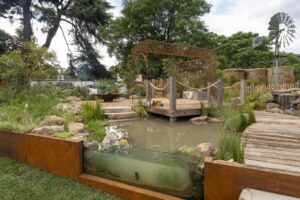
Through the Looking Glass
Designed by Emmaline Bowman (STEM Landscape Architecture & Design) and built by Liam Riley and his team from ID Landscaping, “Through the Looking Glass” received five Show awards including the City of Melbourne Award of Excellence for Best in Show, and the Horticultural Media Association Award for best use of plant life.
This stunning garden provided Show-goers with a modern take on an Australian native garden that also lets them glimpse the life below its surface. “Through the Looking Glass” featured windows looking into the subterranean and aquatic parts of this garden inviting exploration of the hidden ecosystems supporting the healthy plant life above.
“The health of waterways is about the bacterial exchange. Different plant life helps to filter the water,” explains Emmaline, adding that human impacts are threatening these very processes, “And soil systems would not have these healthy environments above if it was not for all the fungi, insects and bacteria that put life into the soil to give life above.”
Inspired by her love for wildlife, Emmaline describes herself as an advocate for Australian plants, so it is not surprising that “Through the Looking Glass” includes only indigenous and native species. As Emmaline explains: “I wanted to show how fabulous our plants are and that you can achieve a meadow garden effect by using them. People find (those gardens) beautiful, and they think they can only get it from European plantings.”
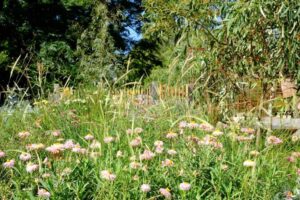
Emmaline included many species from the natural temperate grasslands and the grassy eucalypt woodlands of the Victorian Volcanic Plain. Due to widespread sheep grazing and farming of crops, less than 1% of the original vegetation of this region survives4, inspiring Emmaline’s plant selection in her garden: “I always have this beautiful vision of Themeda (triandra) fields. So, themeda in the background is mixed in with wallaby grasses, poa and (other grasses).”
“The plant species are brought again to showcase how beautiful and how diverse our (indigenous and native) species are. So, you will notice some things that you might not have seen before, like the Diplolaena grandiflora (Native Rose), Actinotis sp. (Flannel Flower) and rare types of boronias, that people probably have never seen before, from the Cranbourne Botanical Gardens. Boronia dichotoma is a pink-flowering boronia which is only found in one area near Lake Grace (in Western Australia), and it closes at night. Many of the flowers that close at night, like your arthropodiums and your wahlenbergias, become like sleeping blankets to bugs. A lot of bugs will go into the flower before they close to be protected during the night,” Emmaline explains before we converse about the potential pollination benefits that these plants may receive from these insects at the same time.
Emmaline is particularly enamoured with the Nicotiana suaveolens on display. With its beautiful trumpet-like flowers, I find it easy to agree with Emmaline’s estimation of the Australian Tobacco. Similarly, Goodenia albiflora (White Goodenia) endemic to South Australia is close to Emmaline’s heart, as is Leptorhynchos squamatus (Scaly Buttons). “I think they are just wacky and wild, and they love to move,” says Emmaline. According to the Botanic Gardens of South Australia’s Plant Selector, Goodenia albiflora can be planted singly for accent in borders, rockeries, nature strips and roundabouts or mass planted as a low informal hedge. This semi-woody small/subshrub attracts native butterflies and insects and is a known caterpillar food plant.
Bringing together this diverse plant life meant that Emmaline had to draw upon the support of multiple nurseries including Vaughn’s Australian Plants, the Royal Botanic Gardens Cranbourne (especially the Veronica arenaria propagated by its Friends group), Ian Taylor from Western Plains Flora (indigenous plants including the Native Tobacco, Themeda triandra, Leptorhynchos spp., Arthropodium spp.), Kuranga Native Nursery, and Oz Watergardens (aquatic species).
“And the (diversity of this) garden is nothing compared to what is out there. There are so many plants that have not even been seen or we have not even got in cultivation yet,” Emmaline ends, highlighting the potential for growth in this industry.
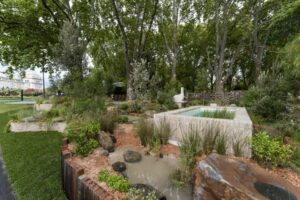
Saltbush
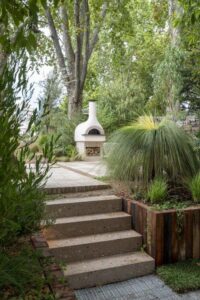
Well-known designers Phillip Withers and Fiona Brockhoff took their visitors on a tour of the Victorian coastline in their delightful “Saltbush” garden, constructed by Longview Landscape Construction. Phillip and Fiona successfully demonstrated that local plants can be both architectural and beautiful, and tied with Emmaline and Liam for the Gold Show Garden Award.
“There has been a really good shift. I think everyone has really noticed that. There are gardens that feel a lot more Australian in terms of not just plant use, but also in terms of design. And I think that it is important that that shift is happening,” says Fiona, “A lot of the gardens that have (received) an award are focused on not just Australian plants but creating urban diversity in their planting and providing habitat for little critters and pollinators. So, it is great to see, isn’t it?”
Like Emmaline, Phillip and Fiona also worked with several nurseries to establish the “Saltbush” plant life including Mt William Advanced Tree Nursery (local species), Peninsula Plants Indigenous Nursery (understorey), Australian Ecosystems (local plants, including wetland species), Warners Nurseries (native trees and shrubs), Kuranga Native Nursery (soft tree ferns), Alpine Treemovals (advanced Banksia integrifolia), Palm Life (local flora), Yarra View (wildflowers) and Lilydale Lawn.
There were over 3,000 plants on display placed in and around approximately twenty tonnes of rock (Phillip’s estimate!) including basalt from Bamstone in Port Fairy. Much of the rock is weathered with lichen and moss and sits well within this constructed landscape. It is beautiful to look at, however, my gaze continued to be drawn back to the plants.
“There are some wonderful stories behind some of the vegetation,” Phillip says, explaining to me that the Victorian Grass Trees (Xanthorrhoea australis) came from an old gravel mine near Wilson’s Promontory in Gippsland. Phillip says that the mine owners were keen to expand operations. However, they were reluctant to do so without protecting the grass trees. Phillip was able to secure three of the grass trees from this site. “That is a hundred years of growth,” Phillip estimates, sizing up the largest grass tree on display as he points it out to me, “To ensure that is not degraded is an important thing. It is better than that being turned into compost because there is way too much history and that is a beautiful, beautiful piece of vegetation that can only help with biodiversity at the end of the day.”
Fiona says that plant diversity does not have to mean that a design loses its cohesiveness: “It is just a simple thing like repeating a tussock. There is Austrostipa stipoides, (moving) through to Poa lab(illardierei) and Themeda australis (triandra). Even though the plant species is changing, the overall look is only shifting slightly. I think if you often thought about including a lot of different plant communities in the one garden, the changes could be quite abrupt. But of course, in nature it is not. And so, you try and emulate that in a garden setting as well.”
Fiona and I discuss the other properties of indigenous and native plants, namely their palatability to humans as well as other creatures. The Atriplex cinerea (Coast Saltbush) from which this garden gets its name is a mighty fine tasty treat when deep-fried, trust me! This also grows in Tasmania, where I got to savour its flavour when I visited the author and Tasmanian native plant expert, Rees Campbell’s residential garden in Wynyard.
“Isn’t it delicious?!” Fiona exclaims, “There are a lot of restaurants doing that now. And there is a lot of the Leucopogon parviflorus (Coast Beard-heath); we eat the berries a lot. It makes wonderful sorbet if you can pick enough (berries). And you know, the carpobrotus (Pigface), their fruits are wonderful. There are so many uses for a lot of the indigenous plants from our areas that I have been learning about from various people including the local Aboriginal people, the Bunurong. It is fascinating when you start realising and understanding the sort of eccentricities of plants, and what they can offer in terms of a food source or something that you can weave or use.”
In addition to plant life and habitat, Fiona acknowledges that “Saltbush” is also a garden for people to use, with a swimming pool and sitting spaces. “There is always that balance in a garden in terms of open usable and planted spaces and how you move through those spaces. You never know when you design something on paper, how it is always going to turn out. I sort of feel like the scale feels comfortable. It is nice to sit down in there and look out in the world. I think it is important to feel held in a garden.”
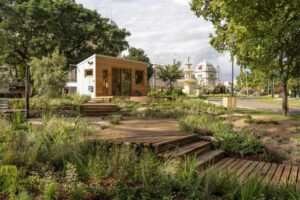
Australian Idyll
Speaking with landscape designer Nadia Cole from Platylobium Landscape Design, I found that we shared several interests, starting with our appreciation for the pea genus endemic to eastern Australia which gives its name to her business. My personal favourite is Platylobium triangulare (Ivy Flat-pea), which I first remember encountering at the Rocky Cape National Park on the Tasmania north coast. For this year’s Show, Nadia drew inspiration from further afield in this state’s high country, a place my recent readers will know that I too have a soft spot for!
Nadia jointly received the Silver Show Garden Award for “Australian Idyll”, along with Christian Jenkins (“Inner Journey”) and Peter Donegan (“A Moment in Time”). Constructed by Atlas Concrete and Landscapes, this garden featured a modern take on a classic bush hut installed by Spaces in Places which is set lightly in an alpine-like environment through which a boardwalk built by Sanctum Homes meanders. Nadia’s design recreates the experience felt by trekkers on the Overland Track in the Cradle Mountain-Lake St Clair National Park.
“I wanted to create a garden to escape from the world, and the Overland Track inspired me,” Nadia explains, “That vision of low foliage, base dense planting, with a rustic boardwalk, (amongst which we have) created some rooms and areas to chill out and escape from the world. It is supposed to be remote. I keep saying you would put (this garden) in a place where people are quite happy to be in this landscape in the nude! So, there is no one else around and you can escape from everything and just hang out.

“I really wanted to bring those big grassy swathes in so that you can walk along the boardwalk and feel immersed in the vegetation. We wanted to make sure that the footprint of the dwelling was much smaller than the garden, and the garden was the place to live. So, the plant life plays a huge role in that. It is all texture based, pulling in a lot of the banksia, leptospermums, and grasses that you get in those natural environments”
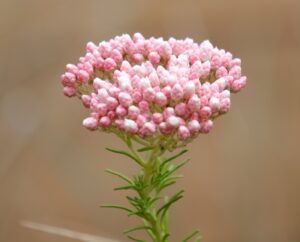
Nadia worked closely with Angus Stewart from Gardening with Angus to supply and install plants sourced from Native Plant Wholesalers and Westland Nurseries amongst others. The plant palette featured both old favourites and newer releases including Correa ‘Choc Leaf’ and Grevillea ‘Mellow Yellow5’.
Correa ‘Choc Leaf’ is a Correa reflexa hybrid that Nadia sourced from Peninsula Growers. Frost and drought tolerant, this compact shrub possesses unique black-brown foliage all year round, with new growth exhibiting salmon-pink tones. Yellow and pink tubular flowers appear from late autumn through to spring. Correa ‘Choc Leaf’ is suitable for low borders and hedges, playground settings and container displays, particularly in coastal settings.
Nadia sourced Grevillea lanigera ‘Mellow Yellow’ from Carawah Nursery. This bird-attracting groundcover has fine light green-grey foliage and bright yellow flowers from winter, although if placed in a sunny location, the floral display can persist year-round. The texture, shape, and size of Grevillea ‘Mellow Yellow’ reminded me somewhat of an Asparagus Fern (Asparagus densiflorus), so I would potentially consider it as an alternative to that plant or its cultivar ‘Myersii’ in more environmentally sensitive areas.
Pink tones feature in the landscape toppings and were picked up in the plant life too, including kangaroo paws (Anigozanthus ‘Bush Pearl’) and rice flowers (Ozothamnus diosmifolius ‘Red Gingham’). Nadia told me that she had fallen in love with this rice flower during the Show, and I think I may have too! “I love the colour and how it pops out, and the variation in the colour. Some plants are white, some are pink, and some have red through their flowers,” Nadia says, adding that ‘Red Gingham’ would make a beautiful locally native alternative to sedums for use in a landscape.

Other plants of note in this “Australian Idyll” included the Correa ‘Catie Bec’ PBR , a highly ornamental small shrub growing to approximately 1 m high x 1.5 m across with pink flowers that make a showy display from autumn through to spring5. Perhaps my favourite, and I will have to declare my bias here, was the Tasmannia lanceolata (Mountain Pepper or Tasmanian Winterberry), which Nadia said people really loved. I know why! This dioecious shrub or small tree is found naturally in wet forests to alpine areas of Victoria and Tasmania (yes, including my family’s bush block!), and is highly ornamental given its glossy green, alternate leaves on reddish-pink stems. Did I forget to mention that it is also edible, with both its fruit and leaves providing a peppery addition to savoury meals.
The final word …
Leaving this year’s Show, I felt like I had finished a multi-day hike across Australia’s south-eastern states. I was tired and foot-weary having navigated my way through so many gardens. However, I felt elated at the sight of all the beautiful indigenous and native plants on display, much like when I visit our national parks in my spare time. The landscape designers I interviewed are helping to raise the profile of our Australian vegetation. I hope that visitors to the Show have a renewed interest in and appreciation of our unique botanical and cultural landscapes as a result, and that this has a flow-on effect economically to the horticulturists and other people who grow these plants.
Common names listed as found in VicFlora (Victorian) or the University of Tasmania’s Key to Tasmanian Dicots (Tasmanian).
Gabrielle Stannus
Inwardout Studio
M: 0400 431 277
E: gabrielle@inwardoutstudio.com
References
- University of Tasmania 2019, Elaeocarpus reticulatus, Key to Tasmanian Vascular Plants, viewed 6 April 2024, https://www.utas.edu.au/dicotkey/dicotkey/ELAEO_CUN_TREM/gElaeocarpus.htm
- Australian Native Plants Society (Australia) n.d., Elaeocarpus reticulatus, viewed 6 April 2024, https://anpsa.org.au/plant_profiles/elaeocarpus-reticulatus/
- University of Tasmania 2019, Mentha australis, Key to Tasmanian Vascular Plants, viewed 28 March 2024, https://www.utas.edu.au/dicotkey/dicotkey/LAM/sMentha_australis.htm
- Greening Australia n.d., Victorian Volcanic Plains, viewed 7 April 2024, https://www.greeningaustralia.org.au/projects/victorian-volcanic-plains/
- Australian Cultivar Registration Authority 2021, Correa ‘Catie Bec’ PBR, viewed 7 April 2024, https://acra.biodiversity.services/info/rdetail/2233

